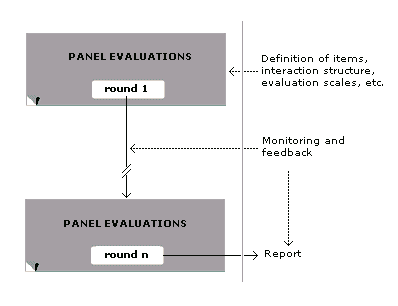4.1 Expert Method Used for Data Collection
Expert methods according to [86] utilize the knowledge and practical experience of experts in the relevant field to obtain: estimates of immeasurable quantities, estimates of data that are not available and whose acquisition would be disproportionately difficult, estimates of future developments (states), proposals for creative solutions, etc. A typical use of experts in this set of methods is for narrow, specialized problems, or especially for general, complex, and intricate problems (i.e., those that are complex, poorly structured, weakly formalized, unique and non-repeatable, with a lack or complete absence of objective qualitative information, etc.) [86]. The expert survey proceeded in the following phases:
- Selection of experts.
- Collection of expert statements.
- Evaluation of expert statements.
4.1.1 The multi-stage Delphi method
The mentioned multi-stage Delphi method [23,86] 1 is a method of obtaining expert opinions with the following properties [86]:
- multiple rounds of surveys with feedback,
- systematic refinement of the group’s opinion,
- anonymity of experts,
- feedback of information,
- experts have access to the group’s opinion and atypical opinions before the next round,
- the possibility to consider circumstances the expert previously did not realize, or the possibility of reevaluating an atypical opinion,
- if an expert insists on an atypical opinion, they must justify it.

4.1.2 Use of the Delphi method for safety research of subway operation
Here is the translation with HTML tags preserved:
The aim of the research conducted in collaboration with the employees of the Prague Public Transport Company was to verify methods for evaluating critical infrastructure and determining the criticality of system components. The research was conducted in the form of an expert survey. Each expert was asked to fill out an electronic form [5,16], and was invited to do so via email.
The group of experts was selected based on recommendations from chosen employees of the metro operator and from selected service providers and suppliers of key equipment necessary for metro operation. Each expert approached in this way had the opportunity to recommend other suitable experts in the following areas: occupational safety and health protection for personnel, property protection, operational economy, passenger protection, and technical and functional safety of operations.
A condition for recommending an expert to the expert team was their long-standing knowledge of metro operations with experience in various areas listed above and at various management levels, i.e., strategic management, tactical and project management, operational management, technical staff, and technical work.
A total of 18 experts were approached, who were asked before the start of the survey to fill out a short questionnaire to determine their qualifications according to [86].
The Delphi method survey was divided into three phases:
- Identification of assets (functions, locations, and parts of the metro system that are important for its safe operation).
- Determining importance and vulnerability.
- Impact scenarios of selected disasters.
4.1.3 Scales used
In the mentioned safety research and in the presented dissertation, we work with criticality K, as a function of importance D and vulnerability Z, in accordance with the definition in section 2.1.3:
K = D x Z
(21)
These quantities depend on the level of the safety management system in which the quantity is assessed, i.e., according to the Defence-In-Depth approach (section 2.1.7 and 2.3.4), and based on the source [18], we follow the following levels (a more detailed description of the levels for the purposes of this research is in Appendix A):
- Safe metro operation under normal conditions (Management level L1).
- Safe metro operation under abnormal conditions (Management level L2).
- Safe metro operation with significant deviations / managing accidents (Management level L3).
- Managing metro operations and assets in critical conditions (Management level L4).
- Managing metro operations and assets in extreme conditions (Management level L5).
